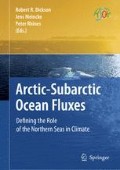Observations of the ocean interior are, in general, sparse relative to the continuum of eddy noise that masks circulation on seasonal and interannual scales. The paucity of observations is particularly acute in remote heavy-weather regions, of which the Labrador Sea is an example. Although the Labrador Sea is a relatively small regional basin in the North Atlantic, few ships traverse it at any time of year, particularly in winter, because its harsh climate limits human habitation around its edges and inhibits exploration of its interior. The lack of intensive observations is in spite of the interesting and important climate signals heavy weather imparts to the region. We report here the application of long-range autonomous underwater glider vehicles in a pilot demonstration of this technology in addressing the need for year-round in situ observations in the Labrador Sea.
The Labrador Sea is well known as a region of intense air–sea interaction in winter. Surface mixed layers deepen to a thousand meters and more in winter, forming a distinct water mass that populates much of the North Atlantic subpolar gyre at shallow and intermediate depths. A portion of this water mass is also exported to the subtropical North Atlantic as well, through boundary currents and interaction with the extension of the Gulf Stream eastward from the Grand Banks across the ocean. In summer, the sea is observed to re-stratify more quickly than can be accounted for by local air–sea fluxes. This puzzle, and others in climate, such as the contribution of boundary currents around the basin to seasonal and interannual changes in heat, freshwater, and volume transport in the global ocean remain unanswered largely because in situ observations are limited by cost and difficulty.
Access this chapter
Tax calculation will be finalised at checkout
Purchases are for personal use only
Preview
Unable to display preview. Download preview PDF.
References
Eriksen, C. C., T. J. Osse, R. D. Light, T. Wen, T. W. Lehman, P. L. Sabin, J. W. Ballard, and A. M. Chiodi, 2001, Seaglider: a long range autonomous underwater vehicle for oceanographic research. IEEE J. Ocean. Eng., 26, 424–436.
Rudnick, D. L., R. E. Davis, C. C. Eriksen, D. M. Fratantoni, and M. J. Perry, 2004, Underwater gliders for Ocean Research. J. Mar. Tech. Soc., 38, 73–84.
Hátún, H., C. C. Eriksen, P. B. Rhines, and J. M. Lilly, 2008, Buoyant eddies entering the Labrador Sea observed with gliders and altimetry. J. Phys. Oceanogr., in press.
Author information
Authors and Affiliations
Editor information
Editors and Affiliations
Rights and permissions
Copyright information
© 2008 Springer Science + Business Media B.V
About this chapter
Cite this chapter
Eriksen, C.C., Rhines, P. (2008). Convective to Gyre-Scale Dynamics: Seaglider Campaigns in the Labrador Sea 2003–2005. In: Dickson, R.R., Meincke, J., Rhines, P. (eds) Arctic–Subarctic Ocean Fluxes. Springer, Dordrecht. https://doi.org/10.1007/978-1-4020-6774-7_26
Download citation
DOI: https://doi.org/10.1007/978-1-4020-6774-7_26
Publisher Name: Springer, Dordrecht
Print ISBN: 978-1-4020-6773-0
Online ISBN: 978-1-4020-6774-7
eBook Packages: Earth and Environmental ScienceEarth and Environmental Science (R0)

